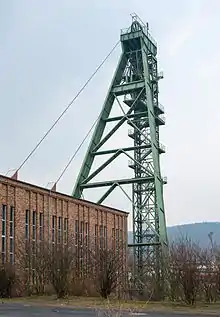Merkers Adventure Mines
Merkers Adventure Mines are a visitor attraction in Krayenberggemeinde in the Wartburgkreis district of Thuringia, Germany, owned and operated by K+S AG of Kassel. They lie near the village of Merkel. The mines have a long history of salt extraction, and hold the record for concealing large amounts of Nazi gold during World War II. A hundred tons of gold and many works of art presumed to be stolen were discovered by the liberating United States Army in 1945.

Context
The Merkers Mine drops 860m below the surface into the 'Werra-Revier' band of potash bearing salt. There, at a constant temperature of 28C, are 4600 kilometers of tunnels.[1] Visitors are lowered in the hoisting cage at over 10m/ sec (30 km/h) down to the 500m galleries. There they are driven on 20-kilometre long tour of the mine, seeing an underground mining museum, a room where in 1945 the 'Gold und Devisenreserven der Deutschen Reichbank' dubbed the Nazi gold was stored, the world's largest underground bucket-wheel excavator, simulated blasting and a laser show in the world's largest underground concert hall.[2] Also, in 1980 a crystal grotto was discovered. Here visitors see enormous salt crystals, some over 1000mm in length.[3]
Popular culture
The salt crystals of Merkers Mine are featured in Episode 2 of the BBC series, The Code.[4]
Gallery
 Manet's Wintergarden in safe keeping in 1945
Manet's Wintergarden in safe keeping in 1945 The Gold Room today
The Gold Room today Salt crystals in the 1980 Crystal Grotto
Salt crystals in the 1980 Crystal Grotto
References
- "4600 Kilometer unter der Erde". Gießener Anzeiger. 2011-02-03.
- Thuringia Tourism
- Erlebnisbergwerk
- "BBC The Code (2011)". Retrieved 26 May 2019.
External links
| Wikimedia Commons has media related to Erlebnisbergwerk Merkers. |
| Wikimedia Commons has media related to Schachtanlage Merkers. |
- Webseite zur 700-Jahr-Feier des Ortes Merkers mit geschichtlichen Informationen
- Erlebnisbergwerk Merkers Slideshow.
- Kristallsalzschlotte im Erlebnis Bergwerk Merkers, Geotopbeschreibung der Thüringer Landesanstalt für Umwelt und Geologie (TLUG)
